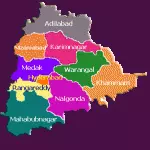Separate Telangana state movement: 1969 Movement
 In the years after the formation of Andhra Pradesh state, people of Telangana expressed dissatisfaction over how the agreements and guarantees were implemented. Discontent with the 1956 Gentleman’s agreement intensified in January 1969, when the guarantees that had been agreed on were supposed to lapse. Student agitation for the continuation of the agreement began at Osmania University in Hyderabad and spread to other parts of the region. Government employees and opposition members of the state legislative assembly swiftly threatened “direct action” in support of the students. This movement, also known as Telangana movement, led to widespread violence and deaths of hundreds of people including 369 students.
In the years after the formation of Andhra Pradesh state, people of Telangana expressed dissatisfaction over how the agreements and guarantees were implemented. Discontent with the 1956 Gentleman’s agreement intensified in January 1969, when the guarantees that had been agreed on were supposed to lapse. Student agitation for the continuation of the agreement began at Osmania University in Hyderabad and spread to other parts of the region. Government employees and opposition members of the state legislative assembly swiftly threatened “direct action” in support of the students. This movement, also known as Telangana movement, led to widespread violence and deaths of hundreds of people including 369 students.
Although the Congress faced some dissension within its ranks, its leadership stood against additional linguistic states, which were branded as “anti-national.” As a result, defectors from the Congress, led by M. Chenna Reddy, founded the Telangana People’s Association (Telangana Praja Samithi). Despite electoral successes, however, some of the new party leaders gave up their agitation in September 1971 and, much to the chagrin of separatists, rejoined the safer political haven of the Congress ranks.
During the movement, the Government promised to correct what critics saw as violation to Gentleman’s agreement in jobs, budget allocations, educational facilities . Prime Minister, Indira Gandhi was strongly against the division of the state but on her recommendation, P. V. Narasimha Rao became first Chief minister of Andhra Pradesh from Telangana on September 30, 1971.
In the year 1972, all candidates belonging to STPS under the leadership of M Sridhar Reddy contested the assembly elections, however, only Mr Thakkalapalli Purushotham Rao got elected from Wardhannapet constituency of Warangal District and rest were defeated. In 1969, Mr Purushotham Rao unveiled Telangana map in the state assembly.Purushotham Rao was for outright separation during the 1969 movement and he supported the student views.
At the end of 1972, when the Supreme Court upheld the Mulki rules, Jai Andhra movement started in Coastal Andhra and Rayalaseema regions protesting the protections mentioned in the Gentleman’s agreement.[8] P. V. Narasimha Rao had to resign as Chief minister of Andhra Pradesh on January 10, 1973. President’s rule was declared in the state. Finally, a political settlement was arrived at under the aegis of the Central Government. A Six-Point Formula was agreed upon by the leaders of the two regions to prevent any recurrence of such agitations in future. The `Six-Point Formula’ included (1) the abolition of Mulki rules and the Telangana Regional Committee (protections mentioned in the Gentleman’s agreement) and (2) the establishment of a Central University at Hyderabad to augment educational facilities. (3) In regards to jobs, state divided into six zones, within the framework of three regions, namely, Coastal Andhra, Rayalaseema, and Telangana (Zone V, and Zone VI) with Hyderabad under Zone VI. Each zone should prefer local candidates for state government jobs. However according to GOM, the regions were rezoned with Zone I,II,III Coastal Andhra, Zone IV Rayalaseema, Zone V,IV Telangana.
Category: Telangana, Telangana History







































Comments (0)
Trackback URL | Comments RSS Feed
There are no comments yet. Why not be the first to speak your mind.